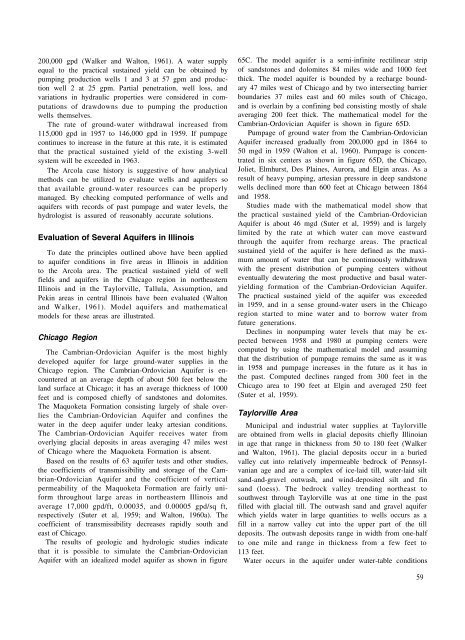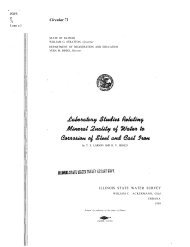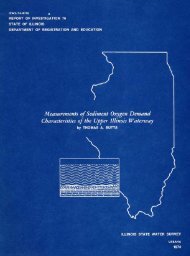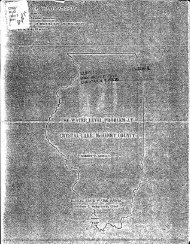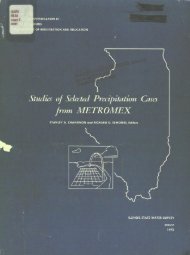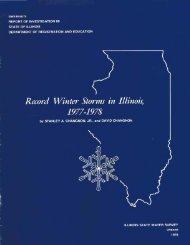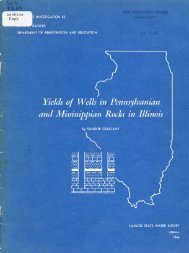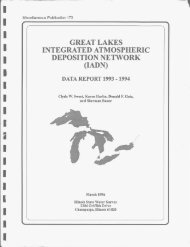Selected Analytical Methods for Well and Aquifer Evaluation
Selected Analytical Methods for Well and Aquifer Evaluation
Selected Analytical Methods for Well and Aquifer Evaluation
You also want an ePaper? Increase the reach of your titles
YUMPU automatically turns print PDFs into web optimized ePapers that Google loves.
200,000 gpd (Walker <strong>and</strong> Walton, 1961). A water supplyequal to the practical sustained yield can be obtained bypumping production wells 1 <strong>and</strong> 3 at 57 gpm <strong>and</strong> productionwell 2 at 25 gpm. Partial penetration, well loss, <strong>and</strong>variations in hydraulic properties were considered in computationsof drawdowns due to pumping the productionwells themselves.The rate of ground-water withdrawal increased from115,000 gpd in 1957 to 146,000 gpd in 1959. If pumpagecontinues to increase in the future at this rate, it is estimatedthat the practical sustained yield of the existing 3-wellsystem will be exceeded in 1963.The Arcola case history is suggestive of how analyticalmethods can be utilized to evaluate wells <strong>and</strong> aquifers sothat available ground-water resources can be properlymanaged. By checking computed per<strong>for</strong>mance of wells <strong>and</strong>aquifers with records of past pumpage <strong>and</strong> water levels, thehydrologist is assured of reasonably accurate solutions.<strong>Evaluation</strong> of Several <strong>Aquifer</strong>s in IllinoisTo date the principles outlined above have been appliedto aquifer conditions in five areas in Illinois in additionto the Arcola area. The practical sustained yield of wellfields <strong>and</strong> aquifers in the Chicago region in northeasternIllinois <strong>and</strong> in the Taylorville, Tallula, Assumption, <strong>and</strong>Pekin areas in central Illinois have been evaluated (Walton<strong>and</strong> Walker, 1961). Model aquifers <strong>and</strong> mathematicalmodels <strong>for</strong> these areas are illustrated.Chicago RegionThe Cambrian-Ordovician <strong>Aquifer</strong> is the most highlydeveloped aquifer <strong>for</strong> large ground-water supplies in theChicago region. The Cambrian-Ordovician <strong>Aquifer</strong> is encounteredat an average depth of about 500 feet below thel<strong>and</strong> surface at Chicago; it has an average thickness of 1000feet <strong>and</strong> is composed chiefly of s<strong>and</strong>stones <strong>and</strong> dolomites.The Maquoketa Formation consisting largely of shale overliesthe Cambrian-Ordovician <strong>Aquifer</strong> <strong>and</strong> confines thewater in the deep aquifer under leaky artesian conditions.The Cambrian-Ordovician <strong>Aquifer</strong> receives water fromoverlying glacial deposits in areas averaging 47 miles westof Chicago where the Maquoketa Formation is absent.Based on the results of 63 aquifer tests <strong>and</strong> other studies,the coefficients of transmissibility <strong>and</strong> storage of the Cambrian-Ordovician<strong>Aquifer</strong> <strong>and</strong> the coefficient of verticalpermeability of the Maquoketa Formation are fairly uni<strong>for</strong>mthroughout large areas in northeastern Illinois <strong>and</strong>average 17,000 gpd/ft, 0.00035, <strong>and</strong> 0.00005 gpd/sq ft,respectively (Suter et al, 1959; <strong>and</strong> Walton, 1960a). Thecoefficient of transmissibility decreases rapidly south <strong>and</strong>east of Chicago.The results of geologic <strong>and</strong> hydrologic studies indicatethat it is possible to simulate the Cambrian-Ordovician<strong>Aquifer</strong> with an idealized model aquifer as shown in figure65C. The model aquifer is a semi-infinite rectilinear stripof s<strong>and</strong>stones <strong>and</strong> dolomites 84 miles wide <strong>and</strong> 1000 feetthick. The model aquifer is bounded by a recharge boundary47 miles west of Chicago <strong>and</strong> by two intersecting barrierboundaries 37 miles east <strong>and</strong> 60 miles south of Chicago,<strong>and</strong> is overlain by a confining bed consisting mostly of shaleaveraging 200 feet thick. The mathematical model <strong>for</strong> theCambrian-Ordovician <strong>Aquifer</strong> is shown in figure 65D.Pumpage of ground water from the Cambrian-Ordovician<strong>Aquifer</strong> increased gradually from 200,000 gpd in 1864 to50 mgd in 1959 (Walton et al, 1960). Pumpage is concentratedin six centers as shown in figure 65D, the Chicago,Joliet, Elmhurst, Des Plaines, Aurora, <strong>and</strong> Elgin areas. As aresult of heavy pumping, artesian pressure in deep s<strong>and</strong>stonewells declined more than 600 feet at Chicago between 1864<strong>and</strong> 1958.Studies made with the mathematical model show thatthe practical sustained yield of the Cambrian-Ordovician<strong>Aquifer</strong> is about 46 mgd (Suter et al, 1959) <strong>and</strong> is largelylimited by the rate at which water can move eastwardthrough the aquifer from recharge areas. The practicalsustained yield of the aquifer is here defined as the maximumamount of water that can be continuously withdrawnwith the present distribution of pumping centers withouteventually dewatering the most productive <strong>and</strong> basal wateryielding<strong>for</strong>mation of the Cambrian-Ordovician <strong>Aquifer</strong>.The practical sustained yield of the aquifer was exceededin 1959, <strong>and</strong> in a sense ground-water users in the Chicagoregion started to mine water <strong>and</strong> to borrow water fromfuture generations.Declines in nonpumping water levels that may be expectedbetween 1958 <strong>and</strong> 1980 at pumping centers werecomputed by using the mathematical model <strong>and</strong> assumingthat the distribution of pumpage remains the same as it wasin 1958 <strong>and</strong> pumpage increases in the future as it has inthe past. Computed declines ranged from 300 feet in theChicago area to 190 feet at Elgin <strong>and</strong> averaged 250 feet(Suter et al, 1959).Taylorville AreaMunicipal <strong>and</strong> industrial water supplies at Taylorvilleare obtained from wells in glacial deposits chiefly Illinoianin age that range in thickness from 50 to 180 feet (Walker<strong>and</strong> Walton, 1961). The glacial deposits occur in a buriedvalley cut into relatively impermeable bedrock of Pennsylvanianage <strong>and</strong> are a complex of ice-laid till, water-laid silts<strong>and</strong>-<strong>and</strong>-gravel outwash, <strong>and</strong> wind-deposited silt <strong>and</strong> fins<strong>and</strong> (loess). The bedrock valley trending northeast tosouthwest through Taylorville was at one time in the pastfilled with glacial till. The outwash s<strong>and</strong> <strong>and</strong> gravel aquiferwhich yields water in large quantities to wells occurs as afill in a narrow valley cut into the upper part of the tilldeposits. The outwash deposits range in width from one-halfto one mile <strong>and</strong> range in thickness from a few feet to113 feet.Water occurs in the aquifer under water-table conditions59


